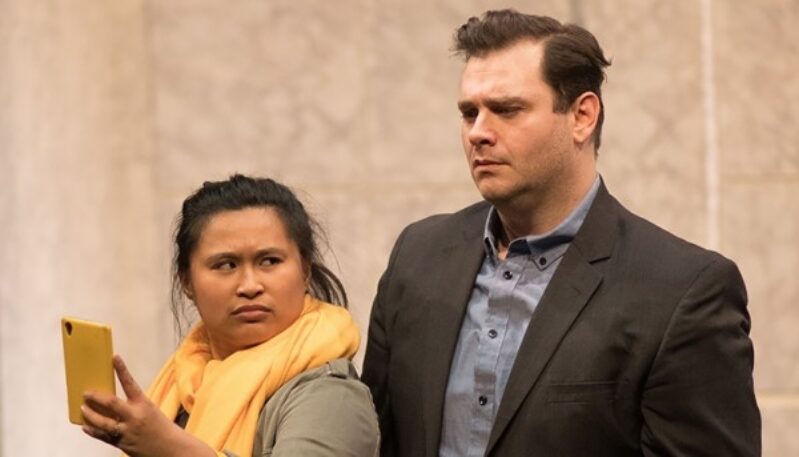Life and Death: A Modern Take on an Age-Old Tale
Review of "Everybody" at Strawberry Theatre Workshop.
Written by TeenTix Press Corps Newsroom Writer Nolan DeGarlais, and edited by Teen Editor Huma Ali!

Everybody dies. While this fact should come as no surprise, the realities of death and what happens after it remains far more mysterious. The uncertainty and unpredictability surrounding death frame the central conflict of “Everybody,” a play written by Branden Jacobs-Jenkins and presented at the Strawberry Theatre Workshop.
In dealing with these heavy, existential themes, which all must inevitably face, the play employs a great deal of comedy interwoven throughout the plot. The experience begins with a monologue by the humorous usher, who comically urges the audience to obey the common courtesies of theater, and details the development of this seemingly age-old story.
”Everybody” draws most directly from a 15th-century English play developed by monks. It was titled “Everyman,” which itself was heavily influenced by an earlier Dutch play that appears to have been shaped by old Buddhist fables. The usher emphasizes a particular belief from Buddhist philosophy that each life is like a bundle of flowers—it is unique and cannot be replicated or brought back once its time on Earth has expired.
While the play has undeniable religious roots, its messages are in no way confined to any one world view. The script expands the theme of coming to terms with human mortality to the modern day, emphasizing the common mortality that binds humans of all identities and periods together, whether they are living in 15th century England or 21st century America.
In this production, apart from the select predetermined roles, (of God, Death, Understanding, Love, and Time), all characters are distributed through a lottery system among the cast members on the night of the event. The randomness of role assignments can lead to 120 variations of the play. Yes, this means that each actor had to memorize the lines of all of the character involved in the lottery. Despite this seemingly insurmountable undertaking, each character delivers a believable performance. And since the plot itself is not altered, a single night of the show left me feeling satisfied in my interpretation of the allegory it offers.

"Everybody" at Strawberry Theatre Workshop. Photo by John Cornicello.
Besides creating a greater appreciation for the actors who memorized the majority of the play, the randomness with which those roles are assigned emphasizes the unexpectedness of death, and the lack of care it has for the preferences of the dying. It also reveals the elements that Jacobs-Jenkins implemented into the fable. Specifically, dealing with identity, and the fact that death cares not for one’s race, gender, or background. Appropriately, no role in the play is based on such characteristics.
The play is set into motion when the usher undergoes a fantastic transformation into ‘God’ and orders “Death” to delivery “Everybody” to him, so that he may conduct an assessment on the state of his creations. After a humorous exchange between the two, “Death” sets out to search the audience for “Everybody”. That’s right; you could be sitting right next to the star of the show, “Everybody”. This intimate feeling is further established by how close the audience sits to the action, which made me feel as though I also was sharing in the existential troubles that “Everybody” faced on stage.
After being chosen by “Death”, “Everybody” embarks on a journey to try to take someone, or something, familiar with them to the afterlife. The potential monotony that could arise from the resulting predictable series of rejections is alleviated by the humor of the dialogue, and the intervening dream sequences, that have been comically adapted to address modern day conflicts. These interactions lead “Everybody” to their final moments on Earth.
The scenes are interspaced with long stretches of pre-recorded conversation in which the audience is submerged in near-total darkness, leaving the impression that they are bearing witness to the dreams of a dying person. While these scenes go a long way in breaking up what could be the monotony of the principal character pleading and being rejected, the commentary on race and culture that they provide often feels out of place with other, more extensively developed themes.
The set design is minimalistic, with a dull marbled gray background, and a single white bench in the center of the stage, but the aspects of it are far from boring. Strobe lighting is used in several scenes, toward the beginning and especially toward the end, to provide a sense of intensity in some scenes. The strobe lights also appear to help separate the visions of the main character from the more “supernatural” elements of the play, such as the opening message from “God”, and the transportation of “Everybody”’s conscience into the afterlife. This transportation into death is aided by a creative, and unexpected, dance sequence that is altogether well-choreographed (at least what I could make out through the rapidly flashing strobe lighting was). The dance sequence, and all the other quirky and unexpected actions that await the audience, help reinforce the randomness of death and the incomprehensible mystery that surrounds its nature.
Ultimately, “Everybody” successfully delivers a story that simultaneously left me amused while also prompted me to extensively consider my own mortality. The seemingly contradictory emotions influenced by this production combine to form an enjoyable experience that successfully leaves the audience humored, but also contemplative, in a manner that few other pieces of work can emulate.
The Teen Editorial Staff is made up of 5 teens who curate the review portion of the TeenTix blog and manage the TeenTix Newsroom. More information about the Teen Editorial Staff can be found HERE.
The TeenTix Press Corps promotes critical thinking, communication, and information literacy through criticism and journalism practice for teens. For more information about the Press Corps program see HERE.


